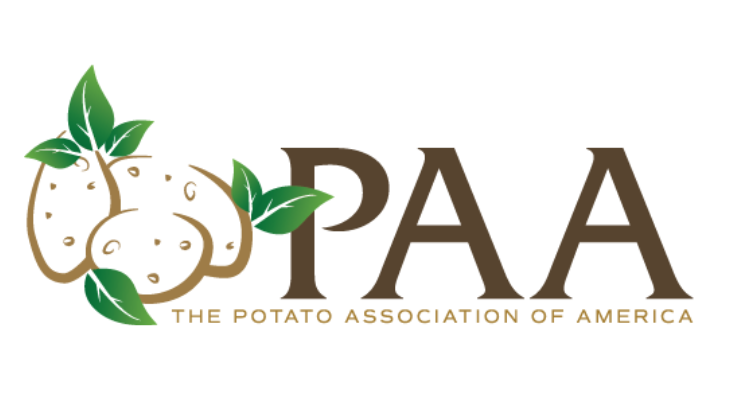
PAA honors 5 student research projects at annual meeting
The Potato Association of America honored graduate students with cash awards for outstanding research presentations at the organization’s annual meeting.
In 2000, an endowment was established to honor the late Frank L. Haynes, longtime professor of potato breeding and genetics at North Carolina State University. For the past 23 years, the PAA has presented the annual awards.
This year, 31 students competed for five awards. The following winners were honored at the meeting, held July 23-27:
Hanna McCoy (first place)

Bio: I am a Ph.D. candidate at the University of New Brunswick and a 2022 graduate of the University of New Brunswick with a Bachelor of Science degree with honors in Medicinal Chemistry.
Research: The Colorado potato beetle is a great threat to the potato industry due to its vast defoliation of susceptible commercial plants. Not only do these pests lead to a significant loss in yields for growers but their adaptive resistance to pesticides have caused the need for new modes of crop protection.
Wild potato species with natural immunity towards Colorado potato beetle have become of interest for potato breeders to produce hybrid commercial varieties with resistance to the beetle.
Solanum okadae, a wild tuber-bearing potato species native to Bolivia and Argentina, has shown significant beetle feeding deterrence in both field and laboratory studies. Analysis of the foliar tissue of this species has revealed the presence of a possible cardiac glycoside – a compound rarely found in Solanaceae. Cardiac glycosides are natural steroidal molecules that are toxic to animals through inhibition of an enzyme – the Na+/K+-ATPase – involved in cardiac muscle contractions. These natural compounds are commonly known for their use in the treatment of heart failure and cardiac arrhythmias but are also a component of some insecticides. To confirm the presence of cardiac glycosides, the foliar tissue has been extracted and compounds are currently undergoing structural analysis.
I have also developed an assay to rapidly screen for the presence of cardiac glycosides in the foliar tissue. Upon addition of potato leaves to a chemical solution, the color of the solution will change from yellow to orange if a cardiac glycoside is present. The absorbance of the solution can then be measured to give the relative amount of cardiac glycoside in the sample. This method will be used in a genetic mapping population where we hope to screen a variety or potato plants for extreme variances in cardiac glycoside production. This approach will help in the identification of genes and DNA markers for cardiac glycoside production in potato.
Once we have deduced the genes responsible for cardiac glycoside production in potato, our goal will be to produce hybrids between S. okadae and S. tuberosum with cardiac glycoside mediated resistance towards Colorado potato beetle. The knowledge obtained from the genetic markers will also allow us to modify and enhance cardiac glycoside production in potato, creating a new source of natural products medicine. This project not only provides environmentally friendly pest management solutions but provides researchers with a new biological target for combatting Colorado potato beetles.
Olee Hoi Ying Lam (second place)

Bio: I am a second-year Ph.D. student at the University of Wisconsin- Madison. I completed both my bachelor’s and master’s degrees in information engineering and computer science at the Rhine-Waal University of Applied Sciences in Germany.
Research: As sensors and machine learning algorithms continue to develop, the use of remote sensing technologies has become increasingly important in agriculture.
New technologies such as imaging spectroscopy (aka hyperspectral imagery or spectral imaging) offer opportunities for site-specific management. In particular, imaging spectroscopy measures how plants reflect light across wavelengths between 400- 2500 nanometers to provide insights into physical and chemical characteristics not obvious to human eyes.
One potential application of imaging spectroscopy is the timely identification of incipient plant stressors, including insufficient water or nutrient availability, the presence of pest infestations and the emergence of diseases. Traditionally, potato field management has relied upon manual field inspections and pre-emptive pesticide application. However, these methods can be time-consuming, costly, and often lead to unnecessary, excessive, or even ineffective pesticide usage. Targeted and more efficient management approaches are needed to ensure sustainable crop health and yield.
My research focuses on using imaging spectroscopy to detect pre-symptomatic early blight, a disease caused by the fungus Alternaria solani. This disease can lead to leaf loss and can make the crop more susceptible to other diseases, ultimately reducing yield and resulting in poorer quality.
In our study, we analyzed the regularly collected airborne hyperspectral images and in-situ observations of plant status. Our analyses revealed that hyperspectral imagery was capable of distinguishing the healthy plots from those that were showing mild symptoms in the lower plant canopies. We were also able to identify specific spectral ranges associated with different disease stages, which provided us with valuable information on the extent and severity of the disease as it developed during the growing season.
Our goal is to develop cost-efficient, spectra-based approaches to support site- specific management. We aim to reduce costs and minimize reliance on fungicides by optimizing the timing of initial and subsequent fungicide treatments based on the information collected through remote sensing technology.
Cyntia Belzil (third place)

Bio: I am a second-year master’s student in plant biology at Université Laval’s Faculty of Agriculture and Food Sciences. I earned my bachelor’s degree in agronomy from Laval University in 2021.
Research: Consumers are increasingly craving unique flavors in their meals. This tendency is particularly impacting the demand for fresh potatoes, which has been on the decline in North America in recent years. To offer more diversity, more attention needs to be paid to flavor potential.
Flavor encompasses the sensations we experience when eating, including taste (sweet, salty, acid, bitter, umami), and aroma, the latter being responsible for the complexity and depth in the perception of what we eat. Hundreds of different volatile molecules are released from the food upon chewing and are binding to olfactory receptors in nasal airways, resulting in the aroma. When you’re eating a not-so-pleasant food and pinching your nose, you are essentially trying to prevent the molecules from reaching your olfactory receptors.
But do potatoes vary that much in terms of flavor? The goal of my project was to characterize the aroma profile of a wide range of potato varieties, ranging from commercial cultivars to landraces. After growing all the lines in the field, the potatoes were cooked, and the volatile compounds were extracted for analysis. The aroma profile that we obtain is associated with the levels of more than 50 different volatile compounds that we measured for each cultivar.
These data allowed us to measure correlations between volatile compounds while also assessing for cultivars that share similarities in aroma. A variety of aroma profiles was observed among the lines, allowing us to evaluate the range of possible values for the different volatile compounds. This large potato collection will enable identification of interesting cultivars with specific aroma. Moreover, the data will provide valuable tools to expedite the breeding of potatoes with unique flavors for fresh consumption.
Evan MacDonald (fourth place)

Bio: MacDonald works as a senior precision agronomist and is pursuing a Ph.D. at UPEI with a project focused on variable rate seeding of potatoes.
Research: The focus of the project is determining the economic impacts of variable rate seed spacing in potatoes. VR seeding is more common in broad-acre crops, and the strategy hasn’t been well researched in North American potato production.
MacDonald’s work in Prince Edward Island in 2021 and 2022 showed that VR seeding outperformed uniform rates four out of six times and resulted in an average profitability increase of $170/acre for the farmer. By spacing seed further apart in the driest areas of the field (i.e. sandy knolls), and tightening seed spacing in the strongest areas of the field, a better size profile and increased yield were achieved. VR seeding was adopted on a commercial scale on over 1,000 acres in 2023 in PEI.
Amaka Ifeduba (fifth place)

Bio: I am a Ph.D. student at Texas A&M University in the potato breeding program. I received my bachelor’s degree in Plant Science and Technology in 2016 and master’s degree in Cytogenetics and Plant Breeding in 2021 from the University of Jos, Nigeria.
Research: The negative impacts of heat stress on potato cultivation have become more severe in recent times, leading to economic losses. A viable solution involves developing heat-tolerant potato varieties that can produce a high yield of marketable tubers. To develop such varieties, breeders must identify parental plants and select offspring based on specific phenotypic traits and molecular markers associated with heat tolerance.
We conducted a comparative study between two potato varieties: the heat- tolerant fresh market russet variety Vanguard Russet from the Texas A&M breeding program and the heat-sensitive processing variety Russet Burbank.
The study was conducted under controlled-growth chamber conditions simulating normal and high-temperature environments. We monitored aspects of tuber growth such as tuber initiation time, bulking, tuber number, plant height and biomass at different stages (30, 45, 75, and 100 days after planting). Our findings revealed distinct characteristics between Vanguard Russet and Russet Burbank in response to heat stress. Despite its slower above-ground plant growth compared to Russet Burbank, Vanguard Russet demonstrated early tuber formation and consistently produced more tubers at all evaluated time points under normal and high-temperature conditions. Both varieties experienced an increase in above-ground biomass under heat stress, with Russet Burbank showing a more pronounced response. However, heat stress significantly reduced tuber formation in Russet Burbank but not in Vanguard Russet.
These results indicate that Vanguard Russet adopts several mechanisms to cope with heat stress effectively. It strategically initiates tuberization early and efficiently directs photoassimilates towards tuber development, utilizing early tuberization, timely allocation and preferential partitioning of photoassimilates to mitigate the impact of heat stress. Even after exposure to heat, Vanguard Russet maintained a significantly higher number and weight of tubers compared to Russet Burbank at 45, 60, 75, and 100 DAP. Russet Burbank exhibited taller plants with more biomass under heat stress conditions.
Our study highlights the potential of Vanguard Russet as a heat-tolerant potato variety, showcasing its adaptive strategies to thrive under challenging conditions.







